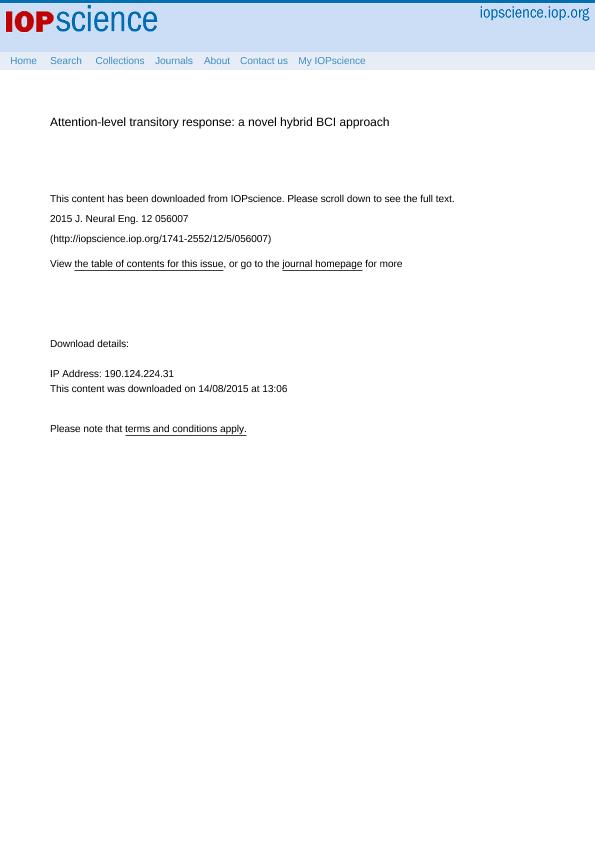Artículo
Attention-level transitory response: a novel hybrid BCI approach
Fecha de publicación:
08/2015
Editorial:
IOP Publishing
Revista:
Journal of Neural Engineering
ISSN:
1741-2560
Idioma:
Inglés
Tipo de recurso:
Artículo publicado
Clasificación temática:
Resumen
Objective. People with disabilities may control devices such as a computer or a wheelchair by means of a brain–computer interface (BCI). BCI based on steady-state visual evoked potentials (SSVEP) requires visual stimulation of the user. However, this SSVEP-based BCI suffers from the 'Midas touch effect', i.e., the BCI can detect an SSVEP even when the user is not gazing at the stimulus. Then, these incorrect detections deteriorate the performance of the system, especially in asynchronous BCI because ongoing EEG is classified. In this paper, a novel transitory response of the attention-level of the user is reported. It was used to develop a hybrid BCI (hBCI). Approach. Three methods are proposed to detect the attention-level of the user. They are based on the alpha rhythm and theta/beta rate. The proposed hBCI scheme is presented along with these methods. Hence, the hBCI sends a command only when the user is at a high-level of attention, or in other words, when the user is really focused on the task being performed. The hBCI was tested over two different EEG datasets. Main results. The performance of the hybrid approach is superior to the standard one. Improvements of 20% in accuracy and 10 bits min−1 are reported. Moreover, the attention-level is extracted from the same EEG channels used in SSVEP detection and this way, no extra hardware is needed. Significance. A transitory response of EEG signal is used to develop the attention-SSVEP hBCI which is capable of reducing the Midas touch effect.
Archivos asociados
Licencia
Identificadores
Colecciones
Articulos(CCT - SAN JUAN)
Articulos de CENTRO CIENTIFICO TECNOLOGICO CONICET - SAN JUAN
Articulos de CENTRO CIENTIFICO TECNOLOGICO CONICET - SAN JUAN
Articulos(INAUT)
Articulos de INSTITUTO DE AUTOMATICA
Articulos de INSTITUTO DE AUTOMATICA
Citación
Diez, Pablo Federico; Garces Correa, Maria Agustina; Orosco, Lorena Liliana; Laciar Leber, Eric; Attention-level transitory response: a novel hybrid BCI approach; IOP Publishing; Journal of Neural Engineering; 12; 5; 8-2015; 1-10; 056007
Compartir
Altmétricas




